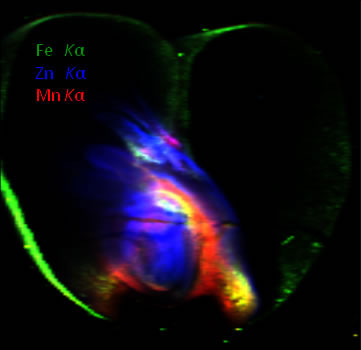| Posted: January 22, 2010 |
Scientists using x-ray vision to produce more nutritious flour |
|
(Nanowerk News) Pioneering research combining plant breeding and high-intensity x-rays is being used by scientists funded by the Biotechnology and Biological Sciences Research Council (BBSRC) to explore the possibility of developing wheat which could be used to make potentially life-saving mineral enriched flour. The research is highlighted in the latest issue of Business, the quarterly highlights magazine of BBSRC.
|
|
Scientists from Rothamsted Research, an institute of BBSRC, are using high powered x-rays from the world famous Diamond Light Source, a third generation synchrotron in Oxfordshire to carry out fluorescence analysis in favour of traditional staining techniques to identify new wheat varieties with added health benefits. This rapid approach not only locates several different minerals simultaneously, but also provides information about their chemistry and digestibility.
|
 |
| X-ray of a cross section of a wheat grain reveals zinc (blue), iron (green) and manganese (red).
|
|
Dr Andrew Neal who leads the project explains: “Essentially we are looking for new healthier grain. Diet deficiency is a big global issue; nearly one million people a year die worldwide as a result of iron and zinc deficiency. Milling methods and our preference for white flour products over wholegrain means that much of the essential mineral content of wheat grains is lost during milling to produce white flour. We are looking for ways to increase iron and zinc quantities in white flour, ensuring they end up in our diet.”
|
|
A wheat grain consists of bran (the outer layer), the germ (or embryo) and white flour (or starchy endosperm). Wheat bran and germ are rich in protein, fibre, oil, vitamins and minerals but the endosperm has little valuable mineral content meaning white flour is virtually devoid of minerals.
|
|
Using an x-ray beam line, Neal exposes grains to microfocussed high intensity x-rays. As the x-rays encounter different minerals, characteristic fluorescence x-rays are emitted. Scanning across the energy range of fluorescent x-rays shows a great deal about the properties of the grains including where and how much of each mineral is present, and how each mineral is complexed within the various regions of the grain.
|
|
Neal explains: “It is certainly early days for this approach, but already we are showing that we can screen-out unsuitable lines early on, preventing breeders wasting investment in them and we are able to view wheat grains in a whole new way. I am hopeful this new approach has real promise to aid nutritious grain development and help answer some of the pressing issues regarding providing more nutritious food from limited productive farmland to feed our increasingly growing population.”
|
|
Commenting on the research, BBSRC Chief Executive Professor Doug Kell, said: "Food security is a huge challenge for the world. We must not forget that it is not enough to secure enough food for people, we must ensure science helps to deliver enough nutritious food. This research has huge potential both in the UK and abroad and could help to develop products that people want to eat, while increasing their mineral content.”
|
|
About BBSRC
|
|
The Biotechnology and Biological Sciences Research Council (BBSRC) is the UK funding agency for research in the life sciences. Sponsored by Government, BBSRC annually invests around £450M in a wide range of research that makes a significant contribution to the quality of life for UK citizens and supports a number of important industrial stakeholders including the agriculture, food, chemical, healthcare and pharmaceutical sectors. BBSRC carries out its mission by funding internationally competitive research, providing training in the biosciences, fostering opportunities for knowledge transfer and innovation and promoting interaction with the public and other stakeholders on issues of scientific interest in universities, centres and institutes.
|
|
The Babraham Institute, Institute for Animal Health, Institute of Food Research, John Innes Centre and Rothamsted Research are Institutes of BBSRC. The Institutes conduct long-term, mission-oriented research using specialist facilities. They have strong interactions with industry, Government departments and other end-users of their research.
|

